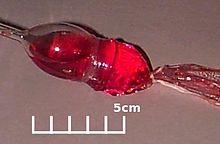- Dialysis tubing
-
Dialysis Tubing or visking tubing is a type of semi- or partially permeable membrane tubing[1] made from regenerated cellulose or cellophane.[2][3] It can be used for diffusion with solutes or osmosis if used with water only. Osmosis is when water passes through a semi-permeable layer to reach equilibrium. Diffusion, on the other hand, allows the movement of molecules from high concentration to low concentration. It will only allow molecules to pass through a semi-permeable membrane or layer if the molecule is small enough to fit through the membrane or a membrane's pore. This usually results with the effects of diffusion through a membrane only really affects small molecules, and almost never larger molecules.[2] Dialysis tubing is used in clinical circumstances to ensure a filtered flow of molecules, preventing the flow of larger solute molecules. Small molecules can be "washed" out of a solution which is pumped through the tubing into a solvent, usually water, which surrounds it and in which they can be flushed away.
Dialysis tubing is permeable to glucose, but not to any starches or proteins. This is because the polymeric protein and starch molecules are too large to pass through the semi-permeable dialysis tubing. This process mimics the function of a semi-permeable cell membrane, which selectively through passive transportation or active transportation allows some molecules to pass through the membrane.
In demonstrations of semi-permeable membranes, a solution containing several types of molecules, usually glucose and starch, is placed into a semi-permeable dialysis bag, such as a cellulose membrane with pores, and the bag is sealed with a knot or elastic band. The sealed dialysis bag is placed in a container of a different solution, or water. Molecules small enough to pass through the tubing (water, salts, monosaccharides, and other small molecules) tend to move into or out of the dialysis bag in the direction of decreasing concentration, therefore displaying diffusion. Larger molecules (such as proteins, or polysaccharides) that have dimensions significantly greater than the pore diameter are retained inside the dialysis bag. The water and smaller solutes in a hypotonic solution (a solution that has a lesser solute concentration than the solution it is referenced to) will cross a semi-permeable membrane, like dialysis tubing, into a hypertonic solution (a solution that has a higher solute concentration than the solution it is referenced to) in an attempt to reach equilibrium, where the solute concentration of each solution is equal.
References
- ^ Dialysis Tubing, York High School
- ^ a b Dialysis, Sigma Aldrich
- ^ Dialysis Tubing, WARD'S Natural Science
Categories:
Wikimedia Foundation. 2010.

